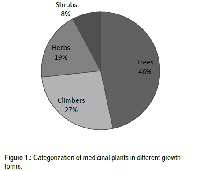An ethnomedicinal survey of medicinal plants from a sacred forest of Western Odisha, India.
Keywords:
Sacred forests, Ethnomedicine, Traditional knowledge, RET species,, iodiversity conservationAbstract
Sacred forests are being protected by means of cultural and religious beliefs by the local communities and act as people participatory conservation sites for several important medicinal plants. Sacred forests are one of the oldest forms of biodiversity conservation sites still effectively managed by local people and act as in-situ conservation sites. In this context, the present study was carried out in Andhari sacred forest of Jharsuguda district as to collect the information regarding the traditional ethno medicinal knowledge acquired by the local medical practitioners. Only few indigenous people have adequate knowledge regarding the medicinal plants and their uses. These traditional knowledge were rapidly degrading and if not documented will be lost forever. The present study reveals the presence of 91 plants species belonging to 46 families being used by the practitioners to treat various diseases like dysentery, diarrhea, indigestion, worm infection, wound healing, headache, stomach disorders, Rheumatic disorders, snake bite, poisonous bite, menstrual problem etc. This ethnomedicinal information further needs to be validated by clinical trials for their safe uses. The study also reported the existence of 8 RET (Rare, Endangered and Threatened) medicinally important species which makes this site a biological hotspot and needs further effective conservation efforts.
References
. Farnsworth NR, Soejarto DD. Global importance of medicinal plants. In: Akerele O, Heywood V, Synge H. (Eds). The Conservation of medicinal plants. Cambridge University Press, Cambridge, UK. 1991; 25-51.
. Groombridge B. (ed.). Global biodiversity. Status of the earth’s living resources. Chapman and Hall, London, Glasgow, New York. 1992; p 594.
. Shankar D, Majumdar B. Beyond the Biodiversity Convention: the challenge facing the biocultural heritage of India’s medicinal plants. In: Bodeker, G., Bhat, K.K.S., Burley, J. and Vantomme, P. (eds.). Medicinal plants for forest conservation and health care. Non-wood Forest Products 11. FAO, Rome. 1997; 87-99
. Ayyanar M. Traditional Herbal Medicines for Primary Healthcare among Indigenous People in Tamil Nadu, India. J Homeop Ayurv Med. 2013; 2(5): 140. doi:10.4172/2167-1206.1000140
. Khan ML, Khumbongmayum AS, Tripathi RS. The sacred groves and their significance in conserving biodiversity: an overview. International Journal of Ecology and Environmental Sciences. 2008; 34(3):277–291.
. Khumbongmayum AD, Khan ML, Tripathi RS. An ethno botanical study of medicinal plants in scared groves of Manipur, Northeast India. Journal of Traditional Ecological Knowledge. 2005; 4(1): 33-38
. Bhakat RK, Pandit PK. Role of sacred grove in conservation of medicinal plants. Indian Forester. 2003; 129(2):224-232
. Behera MK, Pradhan TR, Sahoo J.. Role of sacred groves in the conservation and management of medicinal plants. Journal of Medicinal Plant Research. 2015; 9(29):792-798.
. Pushpangadan P, Rajendraprasad M, Krishnan PN. Sacred Groves of Kerala - A synthesis on the state of -art - of knowledge. In: Conserving the Sacred for Biodiversiw Management. (eds. Ramakrishnan, P.S., Saxena, K.G. and Chandra Shekera U.M).Oxford IBH Publishing Co. Pvt. Ltd. New Delhi. 1998: 193-210.
. Sinha B, Maikhuri RK. “Conservation through `Socio-cultural-religiois Practice' in Garhwal Himalaya: A Case Study of Hariyali Sacred Site.” pp. 289-299.
. Champion HG, Seth SK. A Revised Survey of Forest Types of India. Manager of Publications, Govt of India, Delhi. 1968; p 404.
. Saxena HO, Brahamam M. The flora of Orissa. RRL, Bhubaneswar and Forest Development Corporation publication, Orissa. 1994-96; Vol I -IV : 2918.
. Rawat GS. (Ed.). Special Habitats and Threatened Plants of India. ENVIS Bulletin: Wildlife and Protected Areas. Wildlife Institute of India, Dehradun, India. 2008; 11(1): 239.
. Rout SD, Panda T, Mishra N. Ethnomedicinal plants used to cure different diseases by tribals of Mayurbhanj Distirct of North Orissa. Ethno-Med. 2009; 3(1): 27-32.
. Datta T, Patra AK, Dastidar SG.. Medicinal plants used by tribal population of Coochbehar distirct, West Bengal, India- an ethnobotanical survey. Asian Pacific Journal of Tropical Biomedicine. 2014; 4(suppl 1): s478-s482.
. Pattanaik C, Reddy CS, Das R, Reddy PM. Traditional medicinal practices among the tribal people of Malkangiri distirct, Orissa, India. Natural product radiance. 2007; 6(5): 430-435
. Behera SK, Panda A, Behera SK, Misra MK. Medicinal plants used by the Kandhas of Kandhamal distirct of Orissa. Indian Journal of Traditional Knowledge. 2006; 5(4): 519-528.
. Rout S, Rout S, Sen SK, Satpathy S, Pattanaik D. An ethno-botanical survey of medicinal plants in Semiliguda of Koraput distirct, Odisha, India. Botany Research International. 2012;5 (4): 97-107
. Rout SD, Panda SK. Ethnomedicinal plant resources of Mayurbhanj distirct, Orissa. Indian journal of traditional knowledge. 2010; 9 (1): 68-72.
. Mutthu C, Ayyanar M, Raja N, Ignacimuthu S. Medicinal plants used by traditional healers in Kancheepuram distirct of Tamil Nadu, India. Journal of Ethnobiology and Ethnomedicine. 2006; 2(43):1-10.
. Savitramma N, Linga Rao M, Yugandhar P, Hari Babu R. Ethnobotanical study of Penchalakona forest area of Nellore District, Andhra Pradesh, India. International Journal of phytomedicine. 2012; 4: 333-339
. Mahady GB. () Global Harmonization of Herbal Health Claims. Journal of Nutrition. 2001; 131 (3): 1120S-1123S
. Malhotra KC, Gokhale Y, Chatterjee S, Srivastava S. Sacred groves in India an overview. IGRMS, Bhopal and Aryan Books International, New delhi. 2007; p 186.
. Perumal Samy R, Ignacimuthu S. Antibacterial activity of some folklore medicinal plants used by tribals in Western Ghats of India. Journal of Ethnopharmacology. 2000; 69: 63-71.
. Ramakrishnan PS, Saxena KG and Chandrashekhara UM.(Eds). Conserving the Sacred for Biodiversity Management. Oxford and IBH Publishing Co. Pvt. Ltd.Society. 1998;27: 219-238.



